Zi Wang
Dj
GenesisGeo: Technical Report
Sep 26, 2025Abstract:We present GenesisGeo, an automated theorem prover in Euclidean geometry. We have open-sourced a large-scale geometry dataset of 21.8 million geometric problems, over 3 million of which contain auxiliary constructions. Specially, we significantly accelerate the symbolic deduction engine DDARN by 120x through theorem matching, combined with a C++ implementation of its core components. Furthermore, we build our neuro-symbolic prover, GenesisGeo, upon Qwen3-0.6B-Base, which solves 24 of 30 problems (IMO silver medal level) in the IMO-AG-30 benchmark using a single model, and achieves 26 problems (IMO gold medal level) with a dual-model ensemble.
3DKeyAD: High-Resolution 3D Point Cloud Anomaly Detection via Keypoint-Guided Point Clustering
Jul 17, 2025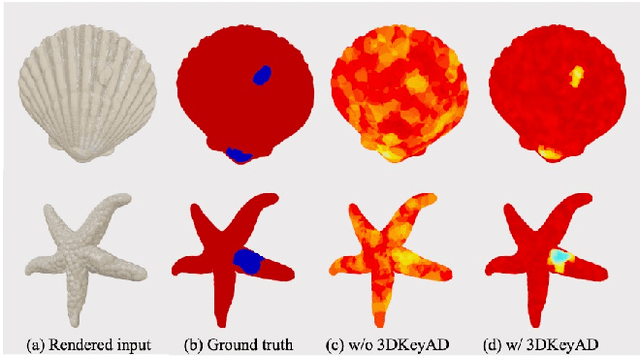
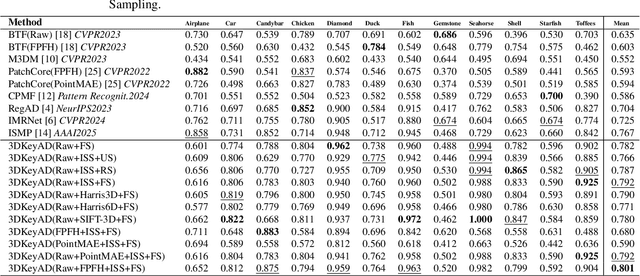
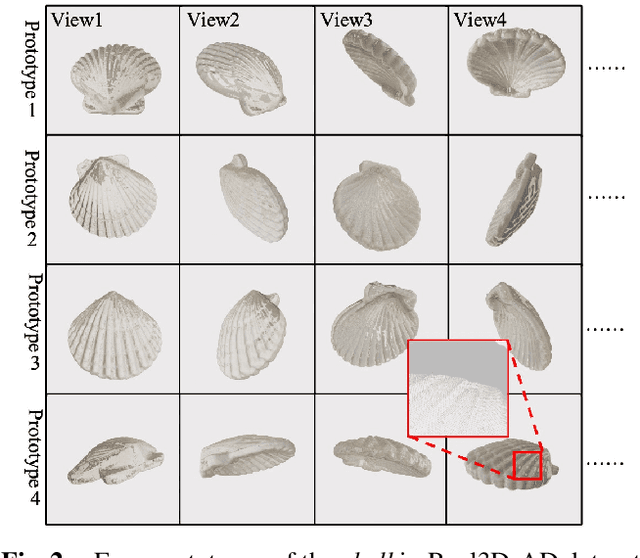
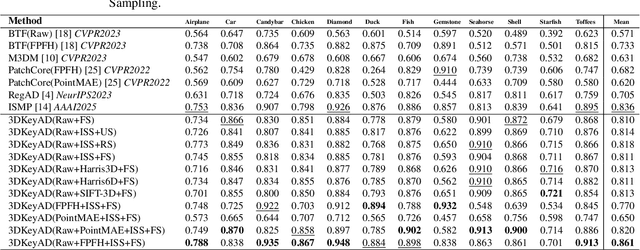
Abstract:High-resolution 3D point clouds are highly effective for detecting subtle structural anomalies in industrial inspection. However, their dense and irregular nature imposes significant challenges, including high computational cost, sensitivity to spatial misalignment, and difficulty in capturing localized structural differences. This paper introduces a registration-based anomaly detection framework that combines multi-prototype alignment with cluster-wise discrepancy analysis to enable precise 3D anomaly localization. Specifically, each test sample is first registered to multiple normal prototypes to enable direct structural comparison. To evaluate anomalies at a local level, clustering is performed over the point cloud, and similarity is computed between features from the test sample and the prototypes within each cluster. Rather than selecting cluster centroids randomly, a keypoint-guided strategy is employed, where geometrically informative points are chosen as centroids. This ensures that clusters are centered on feature-rich regions, enabling more meaningful and stable distance-based comparisons. Extensive experiments on the Real3D-AD benchmark demonstrate that the proposed method achieves state-of-the-art performance in both object-level and point-level anomaly detection, even using only raw features.
Label-Consistent Dataset Distillation with Detector-Guided Refinement
Jul 17, 2025Abstract:Dataset distillation (DD) aims to generate a compact yet informative dataset that achieves performance comparable to the original dataset, thereby reducing demands on storage and computational resources. Although diffusion models have made significant progress in dataset distillation, the generated surrogate datasets often contain samples with label inconsistencies or insufficient structural detail, leading to suboptimal downstream performance. To address these issues, we propose a detector-guided dataset distillation framework that explicitly leverages a pre-trained detector to identify and refine anomalous synthetic samples, thereby ensuring label consistency and improving image quality. Specifically, a detector model trained on the original dataset is employed to identify anomalous images exhibiting label mismatches or low classification confidence. For each defective image, multiple candidates are generated using a pre-trained diffusion model conditioned on the corresponding image prototype and label. The optimal candidate is then selected by jointly considering the detector's confidence score and dissimilarity to existing qualified synthetic samples, thereby ensuring both label accuracy and intra-class diversity. Experimental results demonstrate that our method can synthesize high-quality representative images with richer details, achieving state-of-the-art performance on the validation set.
Harmonizing and Merging Source Models for CLIP-based Domain Generalization
Jun 11, 2025Abstract:CLIP-based domain generalization aims to improve model generalization to unseen domains by leveraging the powerful zero-shot classification capabilities of CLIP and multiple source datasets. Existing methods typically train a single model across multiple source domains to capture domain-shared information. However, this paradigm inherently suffers from two types of conflicts: 1) sample conflicts, arising from noisy samples and extreme domain shifts among sources; and 2) optimization conflicts, stemming from competition and trade-offs during multi-source training. Both hinder the generalization and lead to suboptimal solutions. Recent studies have shown that model merging can effectively mitigate the competition of multi-objective optimization and improve generalization performance. Inspired by these findings, we propose Harmonizing and Merging (HAM), a novel source model merging framework for CLIP-based domain generalization. During the training process of the source models, HAM enriches the source samples without conflicting samples, and harmonizes the update directions of all models. Then, a redundancy-aware historical model merging method is introduced to effectively integrate knowledge across all source models. HAM comprehensively consolidates source domain information while enabling mutual enhancement among source models, ultimately yielding a final model with optimal generalization capabilities. Extensive experiments on five widely used benchmark datasets demonstrate the effectiveness of our approach, achieving state-of-the-art performance.
Generalized Trajectory Scoring for End-to-end Multimodal Planning
Jun 07, 2025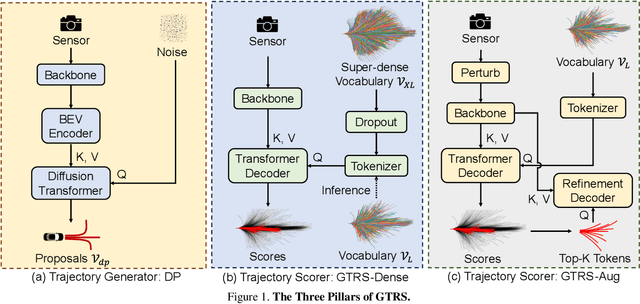

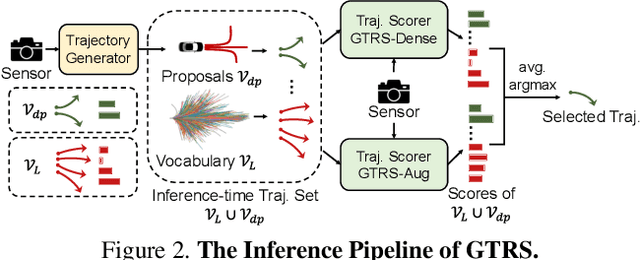
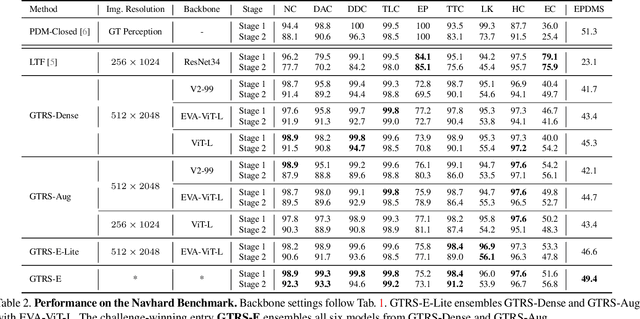
Abstract:End-to-end multi-modal planning is a promising paradigm in autonomous driving, enabling decision-making with diverse trajectory candidates. A key component is a robust trajectory scorer capable of selecting the optimal trajectory from these candidates. While recent trajectory scorers focus on scoring either large sets of static trajectories or small sets of dynamically generated ones, both approaches face significant limitations in generalization. Static vocabularies provide effective coarse discretization but struggle to make fine-grained adaptation, while dynamic proposals offer detailed precision but fail to capture broader trajectory distributions. To overcome these challenges, we propose GTRS (Generalized Trajectory Scoring), a unified framework for end-to-end multi-modal planning that combines coarse and fine-grained trajectory evaluation. GTRS consists of three complementary innovations: (1) a diffusion-based trajectory generator that produces diverse fine-grained proposals; (2) a vocabulary generalization technique that trains a scorer on super-dense trajectory sets with dropout regularization, enabling its robust inference on smaller subsets; and (3) a sensor augmentation strategy that enhances out-of-domain generalization while incorporating refinement training for critical trajectory discrimination. As the winning solution of the Navsim v2 Challenge, GTRS demonstrates superior performance even with sub-optimal sensor inputs, approaching privileged methods that rely on ground-truth perception. Code will be available at https://github.com/NVlabs/GTRS.
DriveSuprim: Towards Precise Trajectory Selection for End-to-End Planning
Jun 07, 2025Abstract:In complex driving environments, autonomous vehicles must navigate safely. Relying on a single predicted path, as in regression-based approaches, usually does not explicitly assess the safety of the predicted trajectory. Selection-based methods address this by generating and scoring multiple trajectory candidates and predicting the safety score for each, but face optimization challenges in precisely selecting the best option from thousands of possibilities and distinguishing subtle but safety-critical differences, especially in rare or underrepresented scenarios. We propose DriveSuprim to overcome these challenges and advance the selection-based paradigm through a coarse-to-fine paradigm for progressive candidate filtering, a rotation-based augmentation method to improve robustness in out-of-distribution scenarios, and a self-distillation framework to stabilize training. DriveSuprim achieves state-of-the-art performance, reaching 93.5% PDMS in NAVSIM v1 and 87.1% EPDMS in NAVSIM v2 without extra data, demonstrating superior safetycritical capabilities, including collision avoidance and compliance with rules, while maintaining high trajectory quality in various driving scenarios.
Decoupling Multi-Contrast Super-Resolution: Pairing Unpaired Synthesis with Implicit Representations
May 09, 2025Abstract:Magnetic Resonance Imaging (MRI) is critical for clinical diagnostics but is often limited by long acquisition times and low signal-to-noise ratios, especially in modalities like diffusion and functional MRI. The multi-contrast nature of MRI presents a valuable opportunity for cross-modal enhancement, where high-resolution (HR) modalities can serve as references to boost the quality of their low-resolution (LR) counterparts-motivating the development of Multi-Contrast Super-Resolution (MCSR) techniques. Prior work has shown that leveraging complementary contrasts can improve SR performance; however, effective feature extraction and fusion across modalities with varying resolutions remains a major challenge. Moreover, existing MCSR methods often assume fixed resolution settings and all require large, perfectly paired training datasets-conditions rarely met in real-world clinical environments. To address these challenges, we propose a novel Modular Multi-Contrast Super-Resolution (MCSR) framework that eliminates the need for paired training data and supports arbitrary upscaling. Our method decouples the MCSR task into two stages: (1) Unpaired Cross-Modal Synthesis (U-CMS), which translates a high-resolution reference modality into a synthesized version of the target contrast, and (2) Unsupervised Super-Resolution (U-SR), which reconstructs the final output using implicit neural representations (INRs) conditioned on spatial coordinates. This design enables scale-agnostic and anatomically faithful reconstruction by bridging un-paired cross-modal synthesis with unsupervised resolution enhancement. Experiments show that our method achieves superior performance at 4x and 8x upscaling, with improved fidelity and anatomical consistency over existing baselines. Our framework demonstrates strong potential for scalable, subject-specific, and data-efficient MCSR in real-world clinical settings.
Reliable Multi-Modal Object Re-Identification via Modality-Aware Graph Reasoning
Apr 21, 2025Abstract:Multi-modal data provides abundant and diverse object information, crucial for effective modal interactions in Re-Identification (ReID) tasks. However, existing approaches often overlook the quality variations in local features and fail to fully leverage the complementary information across modalities, particularly in the case of low-quality features. In this paper, we propose to address this issue by leveraging a novel graph reasoning model, termed the Modality-aware Graph Reasoning Network (MGRNet). Specifically, we first construct modality-aware graphs to enhance the extraction of fine-grained local details by effectively capturing and modeling the relationships between patches. Subsequently, the selective graph nodes swap operation is employed to alleviate the adverse effects of low-quality local features by considering both local and global information, enhancing the representation of discriminative information. Finally, the swapped modality-aware graphs are fed into the local-aware graph reasoning module, which propagates multi-modal information to yield a reliable feature representation. Another advantage of the proposed graph reasoning approach is its ability to reconstruct missing modal information by exploiting inherent structural relationships, thereby minimizing disparities between different modalities. Experimental results on four benchmarks (RGBNT201, Market1501-MM, RGBNT100, MSVR310) indicate that the proposed method achieves state-of-the-art performance in multi-modal object ReID. The code for our method will be available upon acceptance.
Collaborative Enhancement Network for Low-quality Multi-spectral Vehicle Re-identification
Apr 21, 2025Abstract:The performance of multi-spectral vehicle Re-identification (ReID) is significantly degraded when some important discriminative cues in visible, near infrared and thermal infrared spectra are lost. Existing methods generate or enhance missing details in low-quality spectra data using the high-quality one, generally called the primary spectrum, but how to justify the primary spectrum is a challenging problem. In addition, when the quality of the primary spectrum is low, the enhancement effect would be greatly degraded, thus limiting the performance of multi-spectral vehicle ReID. To address these problems, we propose the Collaborative Enhancement Network (CoEN), which generates a high-quality proxy from all spectra data and leverages it to supervise the selection of primary spectrum and enhance all spectra features in a collaborative manner, for robust multi-spectral vehicle ReID. First, to integrate the rich cues from all spectra data, we design the Proxy Generator (PG) to progressively aggregate multi-spectral features. Second, we design the Dynamic Quality Sort Module (DQSM), which sorts all spectra data by measuring their correlations with the proxy, to accurately select the primary spectra with the highest correlation. Finally, we design the Collaborative Enhancement Module (CEM) to effectively compensate for missing contents of all spectra by collaborating the primary spectra and the proxy, thereby mitigating the impact of low-quality primary spectra. Extensive experiments on three benchmark datasets are conducted to validate the efficacy of the proposed approach against other multi-spectral vehicle ReID methods. The codes will be released at https://github.com/yongqisun/CoEN.
QuestBench: Can LLMs ask the right question to acquire information in reasoning tasks?
Mar 28, 2025Abstract:Recently, a large amount of work has focused on improving large language models' (LLMs') performance on reasoning benchmarks such as math and logic. However, past work has largely assumed that tasks are well-defined. In the real world, queries to LLMs are often underspecified, only solvable through acquiring missing information. We formalize this as a constraint satisfaction problem (CSP) with missing variable assignments. Using a special case of this formalism where only one necessary variable assignment is missing, we can rigorously evaluate an LLM's ability to identify the minimal necessary question to ask and quantify axes of difficulty levels for each problem. We present QuestBench, a set of underspecified reasoning tasks solvable by asking at most one question, which includes: (1) Logic-Q: Logical reasoning tasks with one missing proposition, (2) Planning-Q: PDDL planning problems with initial states that are partially-observed, (3) GSM-Q: Human-annotated grade school math problems with one missing variable assignment, and (4) GSME-Q: a version of GSM-Q where word problems are translated into equations by human annotators. The LLM is tasked with selecting the correct clarification question(s) from a list of options. While state-of-the-art models excel at GSM-Q and GSME-Q, their accuracy is only 40-50% on Logic-Q and Planning-Q. Analysis demonstrates that the ability to solve well-specified reasoning problems may not be sufficient for success on our benchmark: models have difficulty identifying the right question to ask, even when they can solve the fully specified version of the problem. Furthermore, in the Planning-Q domain, LLMs tend not to hedge, even when explicitly presented with the option to predict ``not sure.'' This highlights the need for deeper investigation into models' information acquisition capabilities.
 Add to Chrome
Add to Chrome Add to Firefox
Add to Firefox Add to Edge
Add to Edge